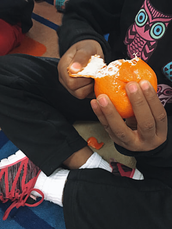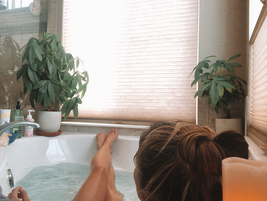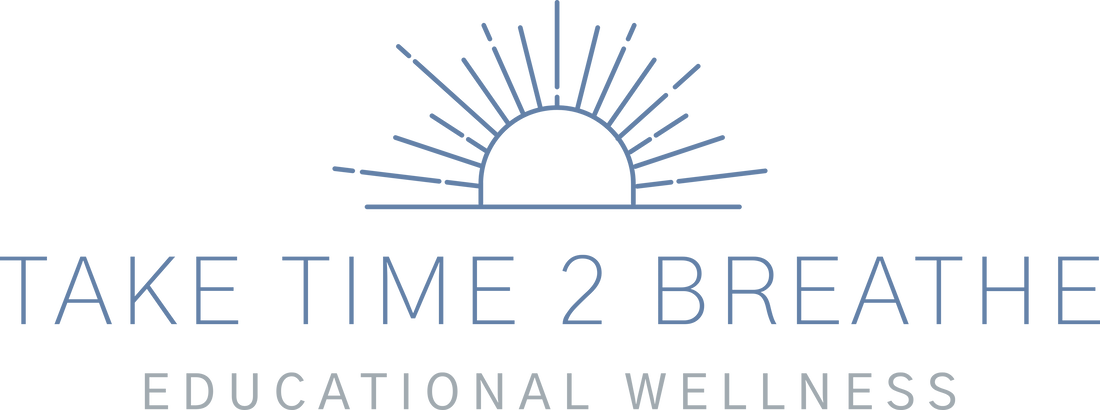Take Time 2 Breathe
|
I have been doing morning mindfulness with my class of second graders since the beginning of the year. I teach it as a part of the routine from the first day of school. It is usually short and quick, and the objective is posted for the students to see.
Objective: Students will be able to use breathing and mindfulness techniques to become calm, focused, and ready to learn. I explain to my students what mindfulness is, why we practice mindfulness, and some of the positive benefits of taking time to pause and breathe (check the mindfulness tab for more on this!). I do this multiple times so students become familiar with what they are doing and why they are doing it. During my morning slideshow, I have one slide dedicated to morning mindfulness that always has the objective posted. I also display the name of the breath, pose, or visualization and a picture that goes along with it. The students become so excited to see what breath or pose they will be doing that day. It takes us about 5 to 10 minutes to complete morning mindfulness. It doesn't take a lot of time but the benefits are plentiful. Toward the middle of the year, my students began creating their own breathing ideas and yoga poses. They would ask to teach their breath to the class, and I always welcome creativity in my classroom! After a few weeks of students coming up and teaching the class, I decided to create a Mindful Creation Bin. In this bin, I have simply offered blank paper and pencils. My students write the name of the breath or pose, draw a picture, and write an explanation of what to do (kids for kids card deck anyone??) I wanted to share this because I realized something very important that day. You can use the beautiful yoga card decks, you can use the wonderful yoga videos and books, you can use your own imagination... but don't forget to utilize the incredibly intelligent and imaginative faces staring back at you every single day. When given opportunities to originate their own ideas, they will blow you away.
0 Comments
It is so important to teach children at an early age that they have tools they can access when they feel intense emotions and need a way to refocus or recenter. Focusing on your breath is a quick and easy way to shift your mindset and bring your focus back to the present moment. Taking deep, purposeful breaths also activates your parasympathetic nervous system and helps to calm your body. I use breathing techniques in the classroom at the very beginning of our day and throughout the day as needed and it makes a huge difference in classroom management. After students are explicitly taught why and how to take deep breaths, they are able to use these techniques to help regulate themselves. You and your students can have a lot of fun learning and coming up with different breaths to do each day. Here are a few of my favorites...  Call and Response >Teacher: One, Two, Three >Students: Everybody Breathe Everyone takes a deep breath in and a slow breath out. ︽  Square Breath > Inhale for 3 > Hold for 3 >Exhale for 3 >Hold for 3 As you do each step, move your finger in an imaginary square in front of your body. ︽  Rainbow Breath Put your hands together at your heart. >Inhale, lift your arms up above you. >Exhale, bring your arms down to your side forming the shape of a rainbow. Repeat as needed. For a fun and energizing version, inhale up the same, and on the exhale explode like a volcano! ︽  Mountain Breath Follow the mountain up with your finger >Inhale for 3 Follow the mountain down with your finger >Exhale for 3 Do this with the rest of the mountains. We've been doing small mindfulness activities in our classroom everyday and I have seen incredible growth in my students. Their ability to empathize with others, solve problems, and regulate their emotions is empowering. Today we did a mindful eating exercise with mandarin oranges. Try this with your students as a way to strengthen your awareness and slow down. Mindful Eating with an Orange >We are going to try a mindfulness activity by eating this orange as slowly as we can and focusing our attention on the act of peeling and eating it. Let's see how slow we can go.
1. Hold the orange in your hand. Look at it closely. What do you notice? Do not try to peel it yet, just notice how it feels and looks in your hand. What can you see? What can you feel? (Some of my students said it reminded them of a pumpkin, others said it looked like the moon with many craters in it. Many agreed the orange felt smooth) 2. Now start to peel your orange, slowly. How does it feel to peel it? Can you focus all of your attention on the orange as you are peeling it? Go as slow as you can. 3. Once you have peeled your orange, before we eat it, smell the orange. How does the orange smell? Does it smell good to you? Does it make your mouth water? How would you describe the smell? 4. Now start to eat the orange as mindfully as you can, with attention. Take a small bite of your orange. What does it taste like? Tangy, sweet, sour, or zesty? 5. After you eat your entire orange, notice how you feel. Is it different to eat something mindfully than to eat food as fast as you can without paying attention? If you tried this with your class, let me know how it went in the comments below! We are currently on spring break in Denver Public Schools and for the first time in a long time I enjoyed a nice stay-cation. I didn't realize how much I needed it until I spent an entire day in bed. I don't often allow myself to just relax, be still, and enjoy the comfort of my home. I am up, tackling the many items on my to-do lists, planning for school, running errands, it. never. ends. But amazing things can happen if you allow yourself to just be. (Things like this website). If we were to list the job description of a 'teacher', the list might include: mentor, nurse, social worker, therapist, life coach, cheerleader, parent, nurturer, shoe-tier, data analyzer, planner, emotion master. There are so many things we must accomplish in a day, that we rarely ever stop to think about what we need to do for ourselves. Teachers are very susceptible to burn-out, compassion fatigue and even second hand post traumatic stress disorder. That is why it is crucial that we are practicing self care and taking care of our own needs. We have to take care of ourselves before we can take care of others. This is why it is one of the first topics on my blog. Practicing self care and having a personal meditation or yoga practice are key to implementing these ideas and strategies into your classroom. In order to create a calm, centered, and creative classroom, you yourself need to feel and experience these things. Are we always going to feel calm, centered, and in control? No. That's not how life works. But we can start to build strategies and skills to bring us back to a state of peace and positivity, even in the face of adversity. Only then can we teach our students the tools and techniques they need to be successful in school and in life. So, what does self care look like? It will look very different for every person. Here are some of my favorite ways I show myself a little love and make sure my needs are met so I am ready to support the students in my classroom. Soothing Bath ~ Start the warm water, add in some essential oils and Epsom salt, turn off the lights and light some candles. Sometimes I will play relaxing music (Norah Jones, anyone?) or read my book. I also have a head pillow with suction cups that stick to the tile for ultimate comfort. I use these calming bath crystal packs from Bed Bath and Beyond, they smell amazing and are super easy to use: Time in Nature ~ This one can be easy but can also be something you plan out. One of the best ways I know how to bring myself back to equilibrium is to hike in the mountains. There is something about being in nature, being surrounded by natural beauty that immediately sends me into a state of peace. I use the hiking trail app AllTrails to search for easy hikes, challenging hikes, hikes near me, or far away. I look up the recent comments from other hikers, the mileage, the difficulty level, and photos to choose which hikes to go on. Don't have time to drive to the mountains? Even a short walk outside can give you the benefits of fresh air and a new outlook on life.
Get Friendly ~ I love, love, love spending time with my friends. Whether we are making dinner, meeting for drinks, going to a yoga class, or having a girls night in, I always feel 100% happier and full of love after spending time with my friends. Reminder: The older you get, the more you realize its not the quantity of friends you have, but the quality of the friendships that will make the difference. Suggestions: Write down a list of 3 things you like to do (eat food, do yoga, watch movies, drink wine, play sports, etc.) and then write down some friends that you like to do those things with. Call them up and schedule some time to do the things you love, with the people you love. Challenge: Pencil in yourself to one of those time slots (reading, taking a bath, meditating). I could write about the ways I practice self love and self care all day. Now I'd love to hear from you! What are some things you do to take care of yourself? Comment below! Also, have you ever used one of these? Just saying.. (No I don't get paid to promote BB&B I promise) One of my favorite resources for implementing mindfulness in the classroom is the Yoga and Mindfulness Practices for Children Card Deck by Jennifer Cohen Harper. I use these cards during my morning mindfulness routine. I teach one card each day Monday through Thursday, and then sequence the cards in order on Friday. Click the link below to see these cards on Amazon: I love these cards because they are not just yoga postures, but incorporate connection with peers, mindfulness, visualization, and other activities to help you and your students come back to the present moment. Do you have other awesome resources you use to implement mindfulness in the classroom? Comment below to let me know!
Last year I discovered the calming and soothing effects of yoga in my personal life, that transferred to my professional life. I took a kids yoga teacher training and started implementing yoga and mindfulness in my kindergarten classroom right away. I saw the most amazing changes in my students. They were able to calm themselves down and control their emotions better, they created authentic relationships with other students, they showed empathy and compassion for their peers, and they were more alert and capable to learn and engage in class activities. I started introducing mindfulness slowly, with a lot of visuals and explanations. Here is one way to start introducing mindfulness in the classroom through breathing and movement. Click the link to download the free lesson plan below:
Hello all and welcome to my blog! My name is Kayla and I am an early childhood educator. I am passionate about yoga and mindfulness in education, and here's why...
I've always been active, healthy and happy. It wasn't until a few years ago that I started noticing how stressed I was and how overwhelmed my students were. I started loosing my hair, feeling exhausted, feeling stressed all of the time and not seeing any end in sight. Teachers are given percentages, scores, and levels that we are required to get students to be able to reach. These academic expectations do not take into account where these students live, who they live with, what language they speak at home, or what experiences they have outside of school. Teachers have to push these students academically while managing the classroom environment, building relationships and supporting their social-emotional development. These students are required to memorize, sit quietly, navigate challenging tasks that they might not be ready for, deal with whatever goes on at home and then leave that all behind at 8am the next morning. My kindergarten students are tested, assessed, forced to memorize facts. It really hit me a few months ago when a few of my students were playing 'teacher'. One child had a piece of paper and a pencil, and was testing one her friends on writing numbers 0-20. She had them write their numbers down and then said "Good, next we are going to test your sight words." At first glance, it might seem cute, but that is how my students are seeing me 'teach'. Rushing to get all of the necessary data throughout the school day for every student on different academic areas, so that I can input all of the data and percentages online by the first of every month. When is there time for me to teach? How are we supporting them emotionally? Are we tracking how well they like school, how interested they are in learning new things, how well they can interact and cooperate with their peers? Do we have time to support their emotional intelligence, problem solving skills, and coping skills? I get tired and overwhelmed just thinking about it. What can we do about all of this? I'm afraid I don't have all of the answers, but I do have some tools and strategies to help fellow teachers and students calm down and take time to breathe. Let's get started. |
|||||||






